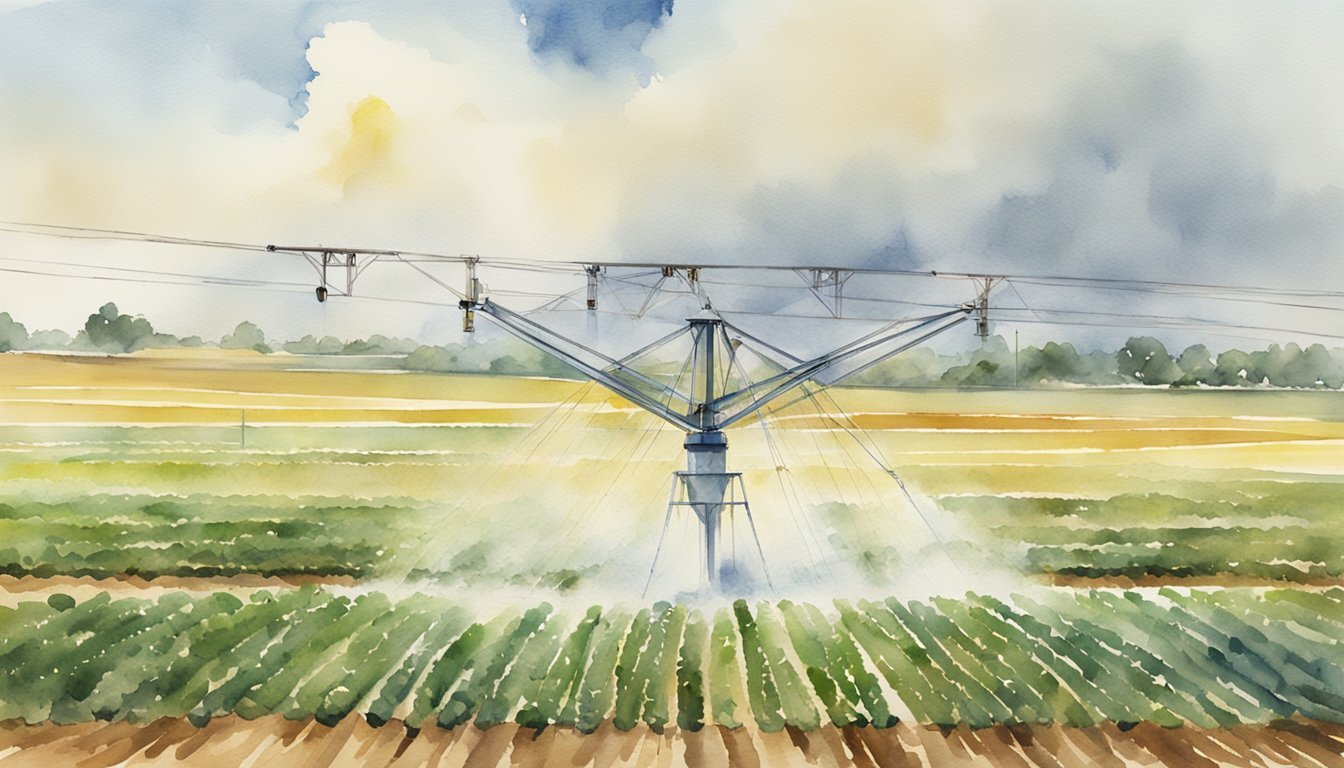Basics of Center Pivot Irrigation
Center pivot irrigation is an efficient method that supports sustainable crop production through precise water distribution. It offers advantages over traditional surface irrigation methods, such as furrow or flood irrigation, by reducing water wastage and improving irrigation control.
Understanding the System
Center pivot irrigation systems operate by rotating around a central pivot point, creating a circular pattern over fields. This circular pattern is fundamental to its design and aids in uniformly distributing water across the landscape. The system’s ability to effectively manage crop water use contributes to greater irrigation efficiency and supports efficient water use in agricultural settings.
Key Components
Key components of a center pivot system include the pivot point, which supplies water, spans or long lengths of pipe connected by trusses and supported by wheeled towers. These spans carry a sprinkler system, which applies water to the crops below. Materials such as aluminum are commonly used for the spans due to their durability and lightness. Electric motors drive the system, and pressure regulators, such as LEPA (Low Energy Precision Application) devices, ensure water is distributed at the correct pressure, improving system performance.
- Pivot Point: Supplies water to the system.
- Spans: Long pipes distributing water, often made of aluminum.
- Trusses: Support the spans.
- Wheeled Towers: Allow movement across the field.
- Sprinkler System: Delivers water to the crops.
- Electric Motors: Drive the system’s movement.
- Pressure Regulators: Maintain proper water pressure.
Installation and Setup
Installation and setup of a center pivot irrigation system require careful system design and planning to ensure optimal water distribution and coverage. Technology such as control panels is incorporated to automate and manage the irrigation system operation. The mechanized nature of the system contrasts traditional furrow or flood irrigation methods, and when installed, it can cover an entire field in a consistent circle pattern, emanating from the central point. The valley terrain can be accommodated by these versatile structures, making them suitable for a variety of agricultural landscapes.
For more specifics on the operation of these machines, one can refer to a detailed explanation on how a center pivot works. To understand the structural configuration and various applications, the Guide to Center Pivot Irrigation with Senninger provides comprehensive insights.
Advantages and Considerations

Exploring center pivot irrigation reveals a spectrum of benefits and important factors for farmers to weigh. This method has transformed water management and enhanced agricultural productivity while presenting considerations for environmental and economic aspects. By optimizing water distribution, center pivot irrigation helps reduce waste and improve crop yields, making it a valuable solution in regions facing water scarcity. In light of the South Africa water crisis, this efficient irrigation method offers a way to maximize limited water resources while sustaining agricultural output. However, farmers must balance the initial investment costs with long-term savings and environmental impacts to ensure sustainable water use.
Water Management and Conservation
Center pivot irrigation systems offer significant advantages in water management, especially in regions prone to drought or where water resources are limited. They deliver water with high efficiency, directly to the root zone of crops, minimizing loss through evaporation or runoff. Innovations such as variable rate irrigation further optimize water application, allowing for precise control over flow rates and reducing waste in areas that do not require as much water.
Enhancing Crop Yield and Quality
The use of center pivot irrigation can lead to consistent and improved crop yield. By ensuring that water delivery is uniform across fields, the irrigation system helps maintain optimal soil moisture levels, which is particularly beneficial for crops like corn that are sensitive to water stress. Additionally, the application of water-soluble fertilizers, or fertigation, through the irrigation system facilitates the efficient uptake of nutrients by plants, promoting better growth and quality of produce.
Environmental and Economic Impact
While center pivot irrigation systems have proven their value in advancing sustainable water use and increasing crop yields, they must be considered in context with environmental and economic impacts. Investment in the technology requires significant capital, but the returns in terms of water savings and higher yields can be substantial. Environmentally, there are advantages in reducing soil erosion and limiting the drift of pesticides, which aligns with the overarching goals for sustainability in agriculture. Moreover, the adoption of this irrigation method by farmers across the Great Plains of the United States, among other regions, has been crucial in conserving the Ogallala Aquifer – a critical groundwater source.

